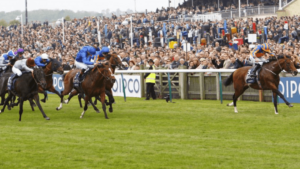Which came first, the 1,000 or 2,000 Guineas?
 Nowadays, the first two Classics of the season, the 2,000 and 1,000 Guineas, are staged on the Saturday and Sunday of the Guineas Festival at Newmarket in late April or early May. The 2,000 Guineas, which is open to three-year-old colts and fillies, was established by the Jockey Club on April 18, 1809. The 1,000 Guineas, which is restricted to three-year-old fillies, followed five years later on April 28, 1814.
Nowadays, the first two Classics of the season, the 2,000 and 1,000 Guineas, are staged on the Saturday and Sunday of the Guineas Festival at Newmarket in late April or early May. The 2,000 Guineas, which is open to three-year-old colts and fillies, was established by the Jockey Club on April 18, 1809. The 1,000 Guineas, which is restricted to three-year-old fillies, followed five years later on April 28, 1814.
Both races are run over a mile on the Rowley Mile Course and took their names from the prize money originally awarded to the respective winners; until the adoption of decimal currency, a guinea was a money of account, standardised at a value of twenty-one shillings. However, since 2001, both races have offered identical prize money, currently guaranteed at £500,000, of which £223,550 goes to the winner.
Both races owe their existence to Sir Charles Bunbury, who became a senior steward at the Jockey Club in 1768 and susbequently adopted the role of ‘perpetual president’. Of course, Bunbury is also credited with co-founding the Derby, alongside Lord Derby, Edward Smith-Stanley, in 1780, but continued to exert a major influence on horse racing until well into the nineteenth century. The other British ‘Classics’, the St. Leger and the Oaks, were first run in 1776 and 1779, respectively, but were not designated as such until after the inaugural running of the 1,000 Guineas.